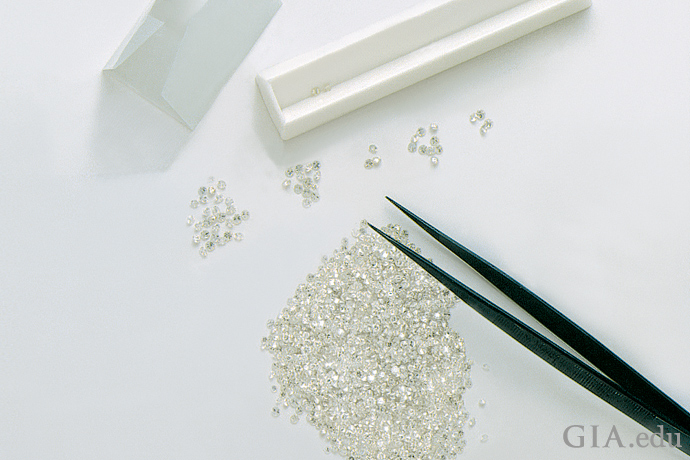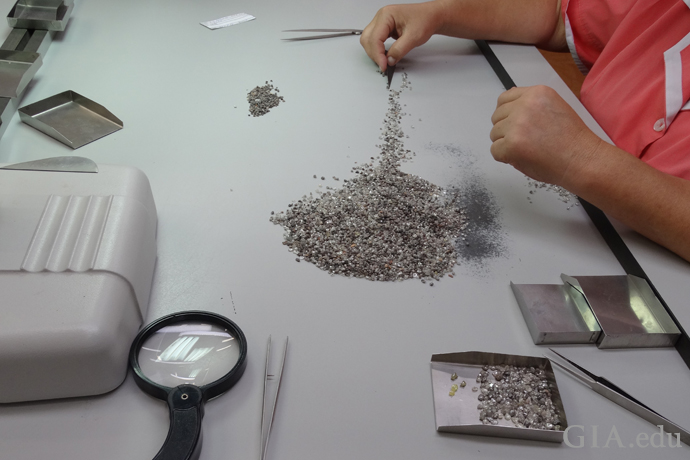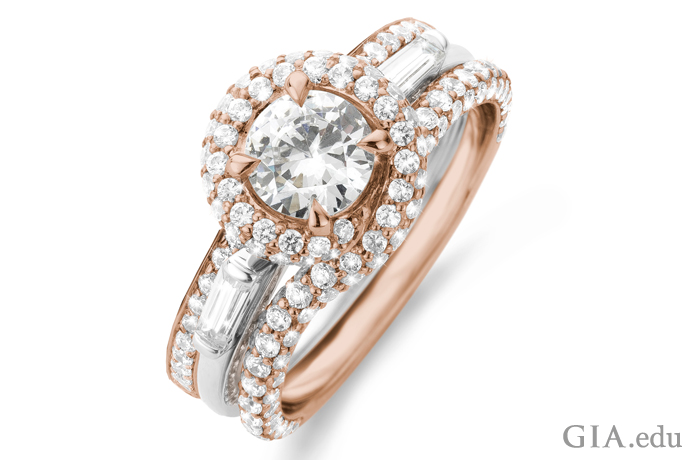Look at a beautiful engagement ring and you might see small diamonds, called melee diamonds (pronounced meh-lee), that accent the center diamond and make the ring pop. Melee diamonds are a popular way to add sparkle to diamond engagement rings.
So what do you need to know about melee diamonds to make an informed purchase?
In this post we’ll cover:
What Are Melee Diamonds
How Melee Diamonds Are Cut
Popular Ring Settings for Melee Diamonds
Melee Diamonds and Your Engagement Ring
What Are Melee Diamonds?
GIA defines melee as small diamonds, either single cut or full cut (see definitions below), weighing less than 1/5 carat (ct). However, the exact size range of melee varies from country to country and from one segment of the trade to another. Melee diamonds can be as small as 0.001 ct (1/1000 of a carat). They are often cut into tiny round diamonds and set around a center stone or on the band.

Hundreds of melee diamonds glitter on a table, waiting to be sorted. Photo: GIA
How Are Melee Diamonds Cut?
Melee diamonds are produced in large quantities in factories that use the latest diamond cutting equipment. High-tech machines have reduced the amount of labor required and improved the quality of the finished product, but cutting and sorting melee is still a labor intensive business. The city of Surat in India is an important manufacturing hub for diamonds, including melee which are faceted, sorted, and sold in parcels of 100 carats or more to jewelry manufacturers who then set them in a wide array of jewelry.
Typical faceting styles for melee include:
- Single cut: A cutting style with a round girdle outline and 17 or 18 facets, depending on whether a culet is present, including a table, eight crown facets, eight pavilion facets and (very rarely) a culet
- Full cut: A round brilliant-cut with 57 or 58 facets, depending on whether a culet is present, including 32 crown facets, 24 pavilion facets, a table and (usually) a culet

Sorting small rough diamonds by hand at Alrosa’s Lomonosov mine, Arkhangel, Russian Federation. Photo: Russ Shor/GIA
Popular Ring Settings for Melee Diamonds
The more diamonds in a ring, the more sparkle it has. Due to their small size, melee diamonds are inexpensive when compared to larger diamond center stones, so they are often generously used in engagement ring designs to add sparkle. You’ll also find them as dazzling accents in watch faces, earrings and pendants – really in any piece of jewelry that calls for added sparkle and brilliance.
- Halo setting: Melee diamonds are the building blocks for this popular setting, where tiny diamonds encircle the center stone. This style can add sparkle to a ring and draw attention to the center stone and make it appear larger.

A halo of melee diamonds makes this engagement ring all the more dazzling. Courtesy: Ziva
- Pavé setting: Pronounced “pah-vey” from the French for “to pave,” is a style of bead setting in which many small gems, like melee diamonds, are set close together to create an interlocking honeycomb pattern. It makes for a dramatic, sparkling look and it’s a setting style often used to make complex designs in engagement rings and other jewelry.

Pavé is the central design element in this cluster ring, pavé set with 3.35 carats of diamonds. Photo: Robert Weldon/GIA
The pavé technique also allows for the creation of more affordable engagement rings, as small diamonds are generally less expensive than larger ones of comparable quality. So an engagement ring with pavé may be a good alternative for those on a budget.

Melee diamonds transform a simple design into an intricate work of art. Courtesy: Laurence Bruyninckx – Antwerp
Melee Diamonds and Your Engagement Ring
While you’ll have to make decisions about the color, clarity, cut, and carat weight of your diamond center stone, it’s unlikely you’ll have to select the melee for your engagement ring. Melee diamonds are sorted by color and clarity prior to being packaged into parcels and sold to jewelry manufacturers, who will then match them to the diamond center stone.
An independent diamond grading report is a must-have for your diamond center stone given its cost and any reputable jeweler will provide one. A grading report is your assurance that your diamond is natural and discloses any known treatments that may have altered its color or clarity. However, don’t expect to receive grading reports for your melee diamonds. There are a number of reasons why, but the overriding one is economic: The cost of grading for melee is too high in relation to their value. Melee are sold in large parcels often containing hundreds of diamonds so it is not practical to have each one graded.
Carat Weight vs Total Carat Weight
When buying a diamond engagement ring with melee diamonds, it’s important to understand the difference between “carat weight” and “total carat weight,” because diamond weight is a driving factor in determining price. Total carat weight, often abbreviated “tcw” in the jewelry industry, is used to describe the combined weight of all the diamonds in a piece of jewelry that only contains diamonds. The description carat weight, abbreviated “ct,” only applies to an individual stone, like the center stone. A ring with many small diamonds with a combined total weight of 2.50 carats (or tcw) can cost significantly less than a solitaire engagement ring with a single diamond weighing 2.50 ct. That’s because larger diamonds are more rare than smaller ones of comparable quality, and therefore they cost more per carat.

Shining like stars in the night sky, some 4.37 carats of melee diamonds twinkle in this luxurious Piaget Limelight tonneau-shaped ladies watch. Courtesy: 1stdibs.com
The sparkle in your engagement ring telegraphs your love to the world. Melee diamonds can make it glow a bit brighter. But if you’re looking to add even more sparkle to your engagement ring, you can go beyond melee diamonds with these additional engagement ring tips.
Custom Field: Array
